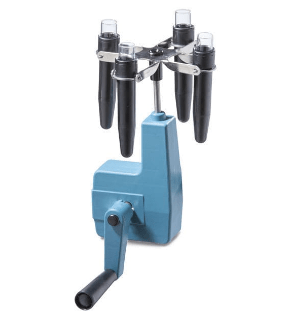Manual centrifuge
Use
It accelerates the sedimentation of solid materials that are suspended in a liquid.

Description
Depending on the model, it has two or four metallic tube holders, of a cylinder-shaped shape, joined to an axis that can be rotated because it is connected to a crank. The set is completed with a screw that allows us to join it to a stable surface, such as a table or a pole.
Functioning
The speed of this process depends on several factors, such as the size of the particles or the density of the liquid, but in any case it can be accelerated if we turn the mixture. This is achieved in the centrifuge if we place the mixture in a tube (called centrifugal cone), in the same way as the tube holder, and manually move the crank, which makes the cone rotate very quickly. The resulting centrifugal force is added to the gravity and a very rapid sedimentation occurs. The shape of the tube facilitates the subsequent decanting of the mixture.

History
The oldest centrifuge model was invented, in 1864, by Antonin Prandtl. Although a copy of this machine has not been found, there is a record of the design of a device, which was published in a polytechnic magazine. It says that this device was created for a machine that worked continuously separating milk from its fat.
In the laboratory, it was used for the first time by Friedrich Miescher, in 1869.
Between 1920 and 1930, the Swedish chemist Theodor Svedberg built the ultracentrifuge, capable of achieving very high rotation speeds.












